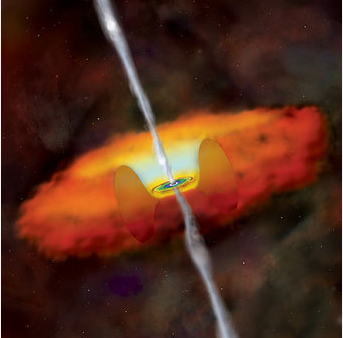
Phd Thesis
Site: Merate (LC)
Duration
3 years
Tutor
Sara Motta
Contact
sara.motta AT inaf.it
Description
Abstract:
Accretion is a fundamental astrophysical process, which throughout the Universe and over a large range of masses leads to the generation of fast, collimated stream of matter called jets. In X-ray binaries an accretion disc formed by matter stripped from a stellar companion is heated up to temperatures of millions of degrees and radiates in the X-ray band, while the associated accretion-fed jets emit synchrotron radiation, visible predominantly in the radio band. Observations in the X-rays and in radio, especially when performed simultaneously, are crucial to understand the input/output balance of matter and energy around accreting objects. Galactic X-ray binaries are relatively close and bright systems, and evolve on humanly accessible times scales. As such, they constitute the best laboratories of extreme physics that the Universe has to offer, where one can study the properties of ultra dense matter, the behaviour of matter and radiation in a strong gravity, and the properties of ultra-relativistic particles.
As part of this thesis the Ph.D. candidate will have the opportunity to learn the techniques and methodologies necessary to reduce, analyze and interpret radio and X-ray data (mostly, but not only, from the MeerKAT radio telescope and the NICER X-ray mission), which will include the development of ad-hoc analysis tools and the testing and further development of dedicated models to interpret the data and to constrain the underlying theory. The Ph.D. candidate will have the opportunity to join the ThunderKAT collaboration, via which s/he will have access to guaranteed MeerKAT radio data on XRBs. Similarly, the student will be involved in the X-ray follow up activities related to the monitoring of interesting XRBs (planning, organization and proposing of observations with NICER and Swift, data reduction and analysis).
Summary:
Accretion is a fundamental astrophysical process, which throughout the Universe leads to the generation of various types of outflows, including fast, collimated stream of matter called jets. Accretion and jets are observed in a large variety of systems, from collapsed stars such as black holes (BHs) and neutron stars (NSs) in X-ray binaries (XRBs) to supermassive BHs in active galactic nuclei (AGN) and even in merging binary black holes or neutron stars that originate the gamma-ray bursts.
In X-ray binaries an accretion disc formed by matter stripped from a stellar companion is heated up to temperatures of millions of degrees and radiates in the X-ray band, while the associated accretion-fed jets emit synchrotron radiation, visible predominantly in the radio band. X-ray binaries display two main accretion regimes, (i) quiescence, with X-rays luminosities as low as 10-7 times the Eddington luminosity, and (ii) outburst, where luminosity dramatically increases, sometimes reaching (or, seldom, crossing) the Eddington luminosity. Some systems are persistent, and spend their lives in some sort of perennial outburst, but many are transient, and spend most part of their lives in quiescence, entering an outburst phase only occasionally. Transient XRBs are of particular interest because they allow to study the accretion ejection across a large luminosity range, which gives the opportunity to probe how the accretion and jet generation processes evolve and interact in different accretion rate regimes.
Observations in the X-rays and in radio, especially when performed simultaneously, are crucial to understand the input/output balance of matter and energy around accreting objects. Galactic X-ray binaries are relatively close and bright systems, and evolve on humanly accessible times scales (from years down to well under a second). As such, they constitute the best laboratories of extreme physics that the Universe has to offer, where one can study the properties of ultra dense matter, the behaviour of matter and radiation in a strong gravity, and the properties of ultra-relativistic particles.
Over two decades of coordinated X-ray and radio observations of X-ray binaries has evidenced strong correlations between their highly variable X-ray emission and the radio emission from their jets (Fender R.P., et al. MNRAS, 396:1370-1382, July 200). Thanks to such observations, repeating patterns of behaviour connecting X-ray states and different modes of outflow have been established, first in black hole X-ray binaries (Merloni A., et al. MNRAS, 345:1057-1076, November 2003, Falcke H., et al. A&A, 414:895-903, February 2004), then in neutron star X-ray binaries, and possibly in AGN (Körding E.G., et al. MNRAS, 369:1451-1458, July 2006; Svoboda J., et al. A&A, 603:A127, July 2017; Férnandez-Ontiveros & Muñoz-Darias, MNRAS, 504:5726-5740, July 2021). In the so-called hard states steady jets dominate the radio. In the soft states the radio emission is quenched, and X-ray winds are seen (Ponti G., et al. MNRAS, 422:L11, May 2012), which may coincide with winds sometimes seen in the hard state (Muñoz-Darias T., et al. Nature, 534:75-78, June 2016). Across the transition from the hard to the soft state, short-lived, powerful relativistic ejections are observed in radio. In X-ray binaries such states are identified thanks to the sources’ spectra and timing properties, the latter as revealed in Fourier power spectra, which are widely used to probe the rapid (sub-second) variability characteristic of these sources.
In particular, narrow peaks that often show in the X-ray (and sometimes Optical/IR) power spectra – called quasi-periodic oscillations (QPOs) – reflect the oscillations of the accretion flow in the strong field regime, and yield accurate centroid frequencies linked to accretion-related time-scales (Motta S.E., et al. MNRAS, 437:2554-2565, January 2014). The results obtained over the years by the proposer have been instrumental in establishing that the study of variability and of QPOs is a key ingredient in understanding the connection between accretion and outflows in X-ray binaries (Motta S.E., et al. MNRAS, 447:2059-2072, February 2015). High time and energy resolution data available thanks to the modern high-sensitivity instrumentation can reveal subtle and/or rapid changes in the energy spectra which were formerly inaccessible (Motta S.E., et al. MNRAS, 471:1797-1818, October 2017), and power spectra reveal abrupt variations reflecting dramatic changes in the accretion flow that would not otherwise be evident (Motta S., et al. MNRAS, 400:1603-1612, December 2009, Motta S., et al. MNRAS, 418:2292-2307, December 2011, Motta S., et al. MNRAS, 427:595-606, November 2012). Time-variability and QPOs, studied through techniques that make full use of both the time and energy information in the data, are by far the most sensitive probes of the accretion flow, which cannot be directly imaged in X-ray binaries.
High cadence and high-angular resolution radio observations are instead the best way to probe the structure and variability of the radio jets from neutron stars and stellar-mass black holes in X-ray binaries (Fomalont E.B., et al. ApJ, 558:283-301, September 2001, Bright J. S., et al. March 2020, Nat. Astronomy, Vol. 4, p.697). Applied simultaneously, these techniques allow the accretion and ejection processes to be probed at the same time, thus enabling us to investigate the input/output of matter and energy in accreting objects.
The NICER mission onboard the International Space Station and the The Neil Gehrels Swift Observatory (Swift) are among the most important observatories currently operational for the study of X-ray binaries. NICER daily observes a large number of interesting XRBs, providing prime quality high time and energy resolution data in the soft X-rays (0.7-12 keV), crucial to obtain the fast-time variability information from these systems. Swift, with its high energy resolution and broad-band sensitivity (0.5-150 keV), and moderate time-resolution provides data best suited to the study of fast spectral variations typical of XRBs. The proposer is highly experienced in the use of several X-ray observatories, and has approved observations and monitoring programs on both NICER and Swift, which guarantee access to high-quality brand new data.
The proposer is a member of the ThunderKAT collaboration which uses the Meerkat to observe weekly XRTs located predominantly in the Southern sky, and regular user of some of the major radio interferometers available (e.g. EVN, eMERLIN, VLBA). Additionally, proposals are being currently submitted to the EVN and the Italian VLBI Network by the proposer to cover the Norther sky in radio.
The student will have the opportunity to join the ThunderKAT collaboration, via which s/he will have access to guaranteed MeerKAT radio data on XRBs. Similarly, the student will be involved in the X-ray follow up activities related to the monitoring of interesting XRBs (planning, organization and proposing of observations with NICER and Swift, data reduction and analysis). The proposer holds a strong collaboration with the University of Oxford (UK), where several members of the ThunderKAT collaboration are located. The student will be visiting Oxford University during year 1 of the project, to be trained in the data reduction and analysis of MeerKAT data (see below).
OBJECTIVES:
- We will develop a pipeline for the quasi automatic reduction of NICER and Swift data, in order to quickly generate data products that can be readily further analyzed and interpreted, with the support of multi-wavelength observations, in particular radio data. Such a pipeline will be used to process the X-ray follow-up data of all the XRB transients monitored weekly by Meerkat with Swift (observing program SwiftKAT, P.I. Motta) and NICER (observations requested ad hoc).
- We will reduce and analyze the MeerKAT radio data using a pipeline developed in Oxford
(OxKAT, https://ui.adsabs.harvard.edu/abs/2020ascl.soft09003H/) by Dr. Ian Heywood, world-leading expert in the use of MeerKAT data (Heywood I. et al, September 2019, Nature, Vol. 573, Issue 7773, p.235-237). - We will analyze simultaneously our X-ray and radio data. By producing power density spectra and broad-band energy spectra, and by applying spectral-timing techniques (e.g. time-lags, rms spectra, cross-correlation functions) to our multi-band observations, we will make full use of energy and timing information in the data, which will help us probe both the details of the accretion processes, and of the accretion-ejection connection.
- We will interpret the data in the context of the accretion-ejection connection, and we will model them using state of the art models in collaboration with the proposer’s collaborators INAF-IASF Palermo, to constrain the properties of the accretion flow and of the jets, and to establish how such processes interact.
[Crediti immagine: MPE]
